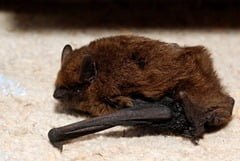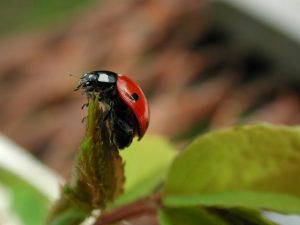-
Bats don’t get caught in your hair: this one has always puzzled me. Bats have one of the most sophisticated sonic navigation systems on the planet, so there’s very little chance of them tangling with your hair, or with anything else for that matter.
-
Bats aren’t dangerous: all Irish bats are insect eaters. They don’t attack larger animals and don’t drink blood. They play a crucial role in keeping insect populations under control, particularly some of our more virulent pest species.
-
Bats aren’t noisy: while it’s true most Irish bats use sound to navigate and search for their prey, these echolocation calls are generally outside the range of human hearing. They may make some audible noise at their roost sites, but even if you share your home with a sizeable bat colony, chances are you’ll never hear them from the house.
-
Bats don’t cause problems in roof spaces: bats don’t gnaw wood and don’t chew electrical cables like rodents – they just hang in their roost to rest after a busy night foraging. Bat guano (droppings) doesn’t cause problems either: it’s made up almost exclusively of chitin — the hard material that makes up the external skeleton of their insect prey. It doesn’t smell, and disintegrates into harmless metallic-looking dust.
 It was Monday night. I sat half-watching a painful American TV show (just because it was on) and half-reading the latest updates to the Ireland’s Wildlife page on Facebook, when a movement outside caught my eye.
It was Monday night. I sat half-watching a painful American TV show (just because it was on) and half-reading the latest updates to the Ireland’s Wildlife page on Facebook, when a movement outside caught my eye.
The long stretch in the evening meant that while it wasn’t exactly light it wasn’t really dark either. I could still see quite clearly; mostly I could see that there was nothing there. I gave up and turned my attention back to the television. Suddenly there was movement again. As I watched a tiny creature emerge from a gap between the tiles and the eaves. It was silhouetted briefly against the darkening sky as it spread its delicate wings, and then disappeared into the night.
The bats were back.
After mating in the autumn, Irish bats hibernate through the winter then stir into life again the following spring. In early summer the gravid females establish maternity roosts in old buildings, attic spaces, under bridges and in other suitably undisturbed locations, where they give birth to and rear their young.
A lot of people cringe at the thought of bats – but their fears are generally unfounded: based on misconceptions rather than fact. If you get to see a bat up close, you’ll soon realise they are fascinating, harmless little creatures, perfectly adapted to the life they lead, and incredibly useful to have around.
Bats in general get a bad press that is far from deserved, so let’s quash a few of the more common bat-related myths right now:
Bat populations in general are in decline as roosting sites are lost to development and increased use of pesticides is both poisoning bats and robbing them of their insect prey. Nine (possibly 10) bat species occur in Ireland, all of them protected by law. It is illegal to disturb bats or to interfere with their roosting sites in any way. Experts consider several Irish bat populations to be of international conservation concern.
I first noticed that we had bats sharing our attic about four years ago. I was checking something in the roof space when I spotted a small, black and brown creature tucked up in the junction of the rafters. It was a brown long-eared bat that had chosen our roof as a hibernation spot. The following summer I noticed bats leaving the roof at dusk, and counted upwards of thirty individuals exiting through a tiny gap between the slates. I suspect these were common pipistrelles or soprano pipistrelles — our smallest and most common bat species. How many use the roof altogether I have no idea… but I’m always very happy to see them return in the summer.
A single pipistrelle, weighing in at no more than six grammes, will wolf down a staggering 3,500 or so midges, mosquitoes and other small insects every night. Without the bats we’d be plagued by much bigger swarms of biting insects on those balmy summer evening — so the bats are welcome… the more the merrier.
For more information on Irish bats, where to find them, how to identify them and how you can help to conserve them, take a look at the Bat Conservation Ireland website (www.batconservationireland.org).
Photo Credit: ![]()
![]() Some rights reserved by Gilles San Martin via Flickr
Some rights reserved by Gilles San Martin via Flickr










3 comments
Sinead McCann
and i have ms too
Sinead McCann
pls help remove these from our home
Calvin Jones
Hi Sinead, I’m afraid removing bats isn’t something I’m either qualified or licensed to do. All Irish bat species are protected under Irish and European law and it is a criminal offence to disturb bats or bat roosts in Ireland. Bats don’t normally cause problems sharing the roofspace of houses, but if you are having issues in your case I’d advise contacting your local National Parks and Wildlife Services Ranger for advice on what you can do. You’ll find contact details on the NPWS Website.
Also check this page on the Bat Conservation Ireland website.